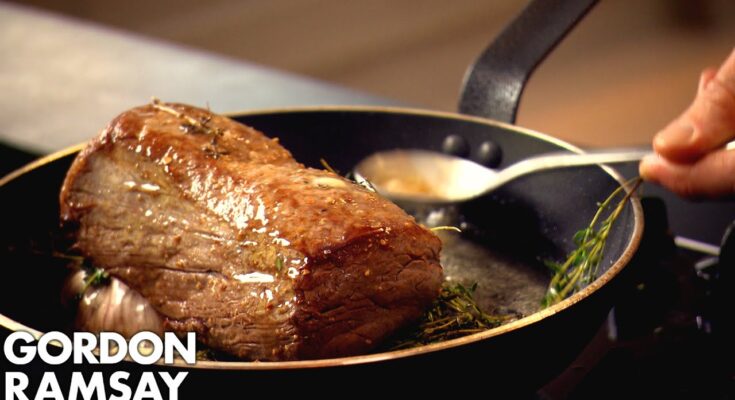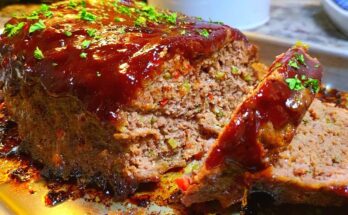Gordon Ramsay Steak Recipe: There’s steak, and then there’s Gordon Ramsay’s steak. Known for his sharp tongue and sharper culinary skills, Gordon Ramsay has transformed the way people cook steak at home. This guide is going to walk you through exactly how to recreate his famous steak recipe right in your own kitchen. Whether you’re cooking for yourself, a date, or trying to impress your family, this method turns a simple cut of beef into a five-star experience.
This isn’t just a steak—this is a masterclass in flavor, technique, and presentation. Get ready to ditch mediocre dinners for good. Let’s dive into the Ramsay way.
The Gordon Ramsay Philosophy Behind the Perfect Steak
Gordon Ramsay isn’t about overcomplicating food. His approach to cooking steak is rooted in respecting the ingredient—starting with a quality cut of beef and elevating it through technique. The result? A steak that’s rich, juicy, and unforgettable.
What makes Ramsay’s style stand out is his emphasis on developing flavors in layers. He doesn’t rely on fancy marinades or overly complex seasoning. Instead, he focuses on a golden crust, aromatic herbs, high-heat searing, and finishing with a glorious butter baste. Simple. Effective. Delicious.
Ramsay often says, “The steak should be the hero of the plate.” That philosophy drives every step in his cooking process.
List of Ingredients You’ll Need
Before you light up the stove, let’s gather all the essential ingredients. Here’s what you’ll need to make a perfect Gordon Ramsay-style steak:
Main Ingredients
- 1 quality steak (Ribeye, Filet Mignon, or Sirloin – about 1.5 inches thick)
- 2-3 tablespoons olive oil
- Sea salt (preferably flaky)
- Freshly ground black pepper
Flavor Enhancers
- 2-3 garlic cloves, lightly crushed with the skin on
- 2-3 sprigs of fresh thyme or rosemary
- 2 tablespoons unsalted butter
Optional Additions
- Dijon mustard (for a subtle tang)
- Finely chopped shallots
- Splash of red wine or balsamic for pan sauce
These ingredients might look minimal, but that’s the point. Ramsay believes in using less but making every element count. Quality over quantity is the name of the game here.
Choosing the Right Cut of Steak
Not all steaks are created equal, and your choice of cut will make a big difference in both flavor and tenderness. Here’s a quick rundown of your best options for this recipe:
Ribeye
Packed with marbling and flavor, this cut is a favorite of Ramsay. It’s juicy and rich, perfect for those who want a luxurious bite.
Filet Mignon
If tenderness is your top priority, filet mignon is king. It’s lean but buttery soft. A bit pricier, but worth it for special occasions.
Sirloin
A more affordable cut that still delivers on flavor. Slightly firmer than ribeye or filet, but ideal if you want a meatier chew.
Bone-in vs Boneless
Ramsay prefers bone-in for added flavor and juiciness, though boneless steaks are quicker to cook. Either way, make sure it’s at least 1 to 1.5 inches thick for best results.
Tools You’ll Need in the Kitchen
The right tools don’t just make cooking easier—they help you cook better. Here’s your Gordon Ramsay steak toolkit:
- Cast Iron Skillet: Holds and retains heat better than anything else
- Tongs: For flipping and basting
- Meat Thermometer: Essential for checking doneness
- Sharp Knife: For slicing cleanly
- Aluminum Foil: For resting the steak without losing heat
Optional but helpful: a basting spoon and a serving board.
Preparing the Steak: Prepping Before Cooking
Preparation is where many people mess up. Ramsay is a stickler for this step because it sets you up for success. Here’s how to do it right:
- Bring the steak to room temperature – Take it out of the fridge 30–40 minutes before cooking. This helps it cook evenly.
- Pat it dry – Use paper towels to remove any surface moisture. Moisture is the enemy of that golden crust.
- Season generously – Don’t be shy with salt and pepper. Season both sides thoroughly.
- Optional: Lightly coat with olive oil – This helps with searing, but avoid drenching it.
At this stage, your steak should be relaxed, dry, and seasoned like it’s ready for the runway. Now it’s time to hit the pan.
Step-by-Step Guide to Cooking Gordon Ramsay’s Steak
Now let’s break it down into exact steps, just like Ramsay does in his kitchen:
Step 1: Preheat the Pan
Get your skillet smoking hot. Ramsay always emphasizes this. You want to hear a loud sizzle the second your steak hits the pan.
Step 2: Season Your Steak (Again)
Right before it goes in, give your steak another light sprinkle of salt. This boosts the crust flavor.
Step 3: Sear the Steak
Lay the steak away from you in the pan. Press it gently down with tongs to ensure full contact. Don’t move it around—let it form a crust for 2-3 minutes.
Step 4: Add Aromatics and Butter
After the first flip, toss in crushed garlic, herbs, and butter. Let the butter melt and foam.
Step 5: Baste the Steak
Tilt the pan slightly and use a spoon to scoop the melted butter over the steak repeatedly. This locks in moisture and builds that nutty, herby flavor Ramsay is known for.
Step 6: Check Doneness
Use a meat thermometer:
- Rare: 120-125°F
- Medium Rare: 130-135°F
- Medium: 140-145°F
- Well Done: 160°F+
Step 7: Let the Steak Rest
This is non-negotiable. Let it rest for at least 8-10 minutes under foil. The juices redistribute and you don’t end up with a dry steak.
Pro Tips from Gordon Ramsay Himself
Gordon Ramsay isn’t just a TV chef—he’s a culinary tactician. Over the years, he’s shared some tried-and-true tips that separate good steak from unforgettable steak. Here are some of his golden nuggets of wisdom that’ll take your steak game to the next level:
Timing is Everything
Steak isn’t something you rush. Ramsay teaches that searing on high heat gives the steak that gorgeous crust, but the key is control. Use high heat for the crust, then slightly lower the flame to allow the inside to cook through without burning the outside. If your pan is too hot the whole time, you’ll end up with a burnt crust and raw middle—not ideal unless you’re aiming for blue rare.
Rest Like a Pro
Ever cut into a steak and see all the juices spill out? Ramsay’s answer: “You didn’t let it rest, did you?” Resting allows those internal juices to redistribute and settle, keeping the steak juicy and tender. No one likes dry meat—no one.
The Power of Basting
This might just be Ramsay’s signature move. Butter basting, combined with herbs and garlic, adds depth and complexity to the steak’s flavor. It caramelizes slightly as you spoon it over the steak, creating an outer layer that’s aromatic, nutty, and seriously mouthwatering.
Bonus Ramsay Hack:
Ramsay sometimes finishes his steaks in the oven—especially if they’re thicker cuts. A quick sear on the stovetop followed by a few minutes in a 400°F (200°C) oven gives you that perfect pink center.
Take these tips to heart, and you’ll go from steak novice to steak master in no time.
How Long Should You Cook Steak?
Let’s be honest: we’ve all overcooked or undercooked steak before. And that’s okay—if you learn from it. The best way to avoid disappointment is to follow time and temperature guidelines. Below is a cheat sheet based on 1.5-inch thick steaks.
| Doneness | Internal Temp | Cook Time (Each Side) | Look & Feel |
|---|---|---|---|
| Rare | 120–125°F | 2–2.5 mins | Cool red center, very soft to the touch |
| Medium Rare | 130–135°F | 3–3.5 mins | Warm red center, tender and juicy |
| Medium | 140–145°F | 4 mins | Pink center, slightly firm |
| Medium Well | 150–155°F | 5 mins | Slightly pink, firm and juicy |
| Well Done | 160°F+ | 6+ mins | No pink, very firm |
Pro Tip: Always insert the thermometer through the side of the steak into the center for an accurate reading.
How to Create the Perfect Crust on Steak
If Gordon Ramsay had a steak mantra, it’d be: “It’s all about the crust.” That irresistible, golden-brown sear on the outside of the steak isn’t just for looks—it’s where most of the flavor lives.
Why Moisture Is Your Enemy
Moisture prevents the Maillard reaction—the chemical process that gives food that browned, caramelized exterior. Before you do anything, make sure your steak is dry. Blot it with paper towels. Even a small amount of surface moisture can sabotage your sear.
High Heat Is Non-Negotiable
Use a cast iron skillet and crank the heat until it’s almost smoking. You should hear a loud sizzle when the steak hits the pan. That’s the sound of flavor in the making.
No Constant Flipping
Let your steak sit in one place. Resist the urge to flip too soon or too often. A minimum of 2–3 minutes per side is essential for a proper crust.
Baste with Butter and Herbs
Once you flip the steak, add butter, garlic, and thyme to the pan. Tilt the pan and use a spoon to baste the top of the steak with the melted butter. This not only helps build flavor but also contributes to that beautifully browned exterior.
Optional Sauce Pairings by Ramsay
While a perfectly cooked steak needs nothing else, sauces can elevate the experience. Gordon Ramsay often prepares simple yet elegant sauces to complement his steaks. Here are a few that pair brilliantly:
Red Wine Reduction
- 1 cup red wine
- 1 tablespoon shallots
- 1 tablespoon butter
- Salt and pepper to taste
Simmer wine and shallots until reduced by half. Stir in butter to finish. It’s rich, smooth, and brings out the beefy flavor of the steak.
Peppercorn Sauce
- 1/2 cup beef stock
- 1/2 cup cream
- 1 tablespoon crushed black peppercorns
- A splash of brandy (optional)
It’s creamy with a spicy kick—one of Ramsay’s go-tos.
Classic Béarnaise
- Egg yolks, tarragon, vinegar, and butter
A luxurious, slightly tangy sauce. If you’re feeling fancy, this one impresses every time.
Plating the Steak – The Ramsay Way
Ramsay believes that we eat with our eyes first. The way you plate the steak matters more than you might think. Here’s how to serve it like a pro:
Slice Before Serving (Optional)
If you’re serving family-style or want to show off the juicy pink center, slice the steak against the grain at a slight angle. This makes it easier to chew and looks gorgeous.
Less Is More
Ramsay isn’t into overloaded plates. Place the steak slightly off-center and let it shine. Add a small serving of your chosen sides, like mashed potatoes or greens, and maybe a drizzle of sauce on the side.
Garnish with Purpose
A sprig of rosemary or a few crispy garlic chips can add that final touch of finesse without stealing the show.
Common Mistakes to Avoid
We’ve all made steak mistakes. But Ramsay teaches that most are totally preventable. Here are some common errors and how to dodge them:
- Cooking steak straight from the fridge: Always let it come to room temp before cooking.
- Under-seasoning: Don’t be shy. Steak loves salt and pepper.
- Crowding the pan: Only cook one or two steaks at a time to maintain heat.
- Cutting it too soon: Let it rest to avoid losing all the juices.
- Using non-stick pans: Cast iron is king. It retains heat and creates the best crust.
Nutritional Facts of a Gordon Ramsay Style Steak
Here’s a rough breakdown for a single 8 oz (226g) ribeye steak cooked the Ramsay way, without additional sauces:
| Nutrient | Amount |
|---|---|
| Calories | 550–650 kcal |
| Protein | 45–50g |
| Total Fat | 40–45g |
| Saturated Fat | 18–20g |
| Carbohydrates | 0g |
| Fiber | 0g |
| Sodium | 300–400mg |
Of course, sauces and sides will change these numbers significantly.
What to Serve with Gordon Ramsay Steak
Ramsay always pairs his steak with simple, flavor-packed sides. Here are some classic and creative pairings:
Creamy Mashed Potatoes
Fluffy, buttery mashed potatoes balance the rich umami of the steak perfectly.
Grilled Asparagus or Broccolini
These veggies add color, texture, and a fresh bite. Ramsay usually blanches them first and then finishes with a quick char.
Garlic Mushrooms
Sautéed mushrooms in garlic butter pair beautifully with steak, enhancing the earthy notes.
Wine Pairing
- Ribeye: Cabernet Sauvignon or Syrah
- Filet Mignon: Pinot Noir
- Sirloin: Malbec or Merlot
These pairings elevate your meal into a fine dining experience.
FAQs about Gordon Ramsay Steak Recipe
1. Can I cook this steak without a cast-iron skillet?
Yes, you can use a stainless-steel pan, but avoid non-stick pans. They don’t get hot enough to create that perfect sear.
2. How do I make the steak more tender?
Choose the right cut (like filet mignon), and don’t overcook it. Also, always slice against the grain when serving.
3. What’s the best substitute for thyme?
Rosemary is a great alternative. You can also try sage or oregano depending on your taste preference.
4. Can I use this method for other meats?
Absolutely! This technique works well with lamb chops, pork steaks, and even chicken breasts—just adjust the cooking times accordingly.
5. How to make it kid-friendly?
Skip the wine-based sauces, use leaner cuts like sirloin, and serve with fun sides like sweet potato fries or buttered corn.
Conclusion
There you have it—the full breakdown of how to cook a steak like Gordon Ramsay. With simple ingredients, proper technique, and attention to detail, you can transform an ordinary piece of meat into something extraordinary. Ramsay’s method is about control, timing, and respecting the ingredients. Whether you’re a seasoned home cook or a beginner, mastering this steak will boost your kitchen confidence tenfold.
So, next time you’re craving a steakhouse meal, don’t make a reservation—make it yourself. You now have the blueprint.



